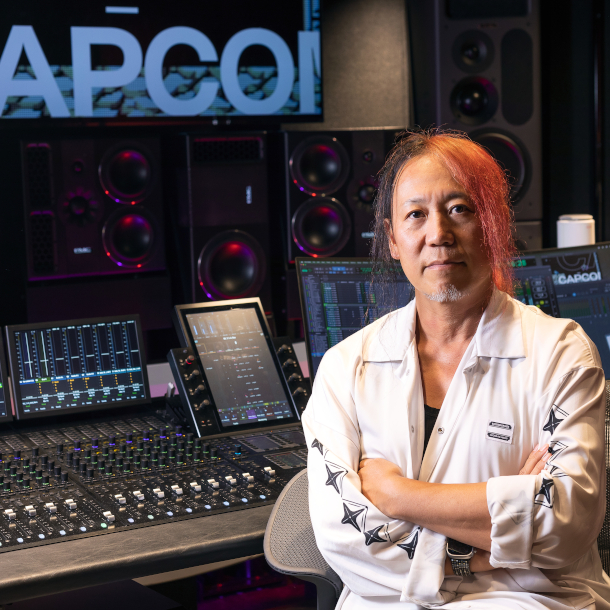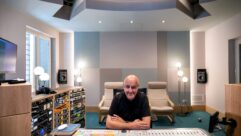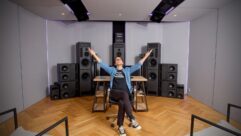
The globally renowned Japanese games developer Capcom has chosen PMC loudspeakers for its new Dolby Atmos immersive audio Dubbing Stage in Osaka where the system is already being used to mix major titles such as Resident Evil 4 and STREET FIGHTER 6.
The 7.1.4 channel system comprises PMC IB2S XBD-A II stereo speakers installed on both sides. PMC6-2 monitors were chosen for the height and rear/horizontal positions, along with four PMC8 sub woofers for bass.
Kazuya Takimoto, Senior Sound Engineer/Mixer at the company says he is delighted with the sound of the new studio, which has turned out even better than imagined, both in terms of looks and functionality.
“People who listen to the sound in this room all exclaim ‘Wow!’ in unison,” he says. “I once visited Sony Computer Entertainment’s Santa Monica Studio during an AES show in Los Angeles and felt envious of the environment where they create game audio. However, after the renovation, our new studio has become something to be proud of on a similar level.”
Based in the R&D building near its headquarters in Osaka, Capcom’s bitMASTERstudio is an in-house facility that is used to produce much of the game sound and music for titles such as Monster Hunter and the Resident Evil series. In 2022, Capcom carried out extensive renovations to bitMASTERstudio, transforming the facility into the three-studio complex that it is today.
The inspiration for these changes was the overhaul of Capcom’s Dynamic Mixing Stage: GOLD room in 2018, which was designed and constructed by acoustic specialists SONA. According to Mr. Takimoto, establishing solid room acoustics for this studio achieved such fantastic results that it became the vision for the renovation of Dubbing Stage.
“Dynamic Mixing Stage: GOLD showed us that, when stabilizing room acoustics, the phantom localization improved remarkably,” Mr. Takimoto explains. “In 3D game audio, all sound sources are objects and are reproduced based on their coordinates, creating an omnidirectional sound field. Even if it’s just dialogue, there is a possibility that it could be positioned in a very awkward (halfway) location, so if the phase of the entire monitor system isn’t stable, it becomes difficult to determine whether the discomfort is due to the room or to the sound processing.”
Mr. Takimoto adds that the improvements made to Dynamic Mixing Stage: GOLD allowed for precise positioning of all sound images, thus giving engineers the freedom to focus solely on sound quality and balance during mixing.
“This is truly important for producing game audio,” he says. “Consequently, in 2022 we took the decision to renovate Dubbing Stage and add a new room, Dynamic Mixing Stage: SILVER.”
Once again, SONA was responsible for the redesign of Dubbing Stage, which now has a completely renewed interior structure and an exciting new aesthetic with the theme of an ‘adult social space’. Looking more like a nightclub than a typical in-house games studio, Dubbing Stage has a crescent-shaped panel at the back of the console, which was installed to hide the base of the speakers.
“I wanted something impressively impactful so that visitors to the studio would immediately say ‘what is this?’,” Mr. Takimoto says. “The idea of a waning moon popped into my mind, and I thought it would look cool if the speakers were illuminated from beneath the crescent. The crescent design doesn’t have an acoustic significance, but people other than producers and sound design team members also come to the studio, so having cool design elements like this can uplift the mood. The studio’s ambiance is, in my opinion, highly essential for carrying out creative work.”
Mr. Takimoto’s decision to install a PMC monitoring system was inspired by a demo he heard at Inter BEE 2019 where PMC’s distributor Otaritec was showcasing the company’s flagship QB1-A loudspeakers.
“The sound had a punchy quality that I really liked,” he explains. “In the initial design phase for the Dubbing Stage renovation, I was considering a combination of IB2S-AII for the front LCR, PMC’s twotwo series for surround, and the wafer series for height channels. However, when we started the renovation, the twotwo series had already been discontinued. Therefore, I listened to PMC’s new monitors that were designed as a replacement for the twotwo’s in SONA’s listening room. Since I had been considering the two-way twotwo series, I initially had the PMC6 as my first choice, but when I listened to the three-way PMC6-2, I was completely fascinated. I brought some of my reference tracks, and when I played a song that started with a piano, I was immediately captivated by the first note. I felt like, ‘Wow, this is it!’ and I decided on the PMC6-2. Of course, PMC6 was great, but the sound I was looking for was in the PMC6-2. I really liked the midrange tone of PMC6-2’s squawkers, and in terms of the harmony with the IB2S-AII, which I was considering for stereo playback, PMC6-2 was superior.”
The PMC6-2 height speakers are mounted on the ceiling using custom brackets made of steel and vibration-damping rubber. The rear/horizontal PMC6-2 speakers are installed on custom speaker stands. In addition to the four PMC8 SUB subwoofers, the LFE input of IB2S XBD-A II is also utilized.
“I don’t like the LR speakers to be too far apart, so I set the angle for PMC6-2 LR at 45°, and for the IB2S XBD-AII, which is primarily for music, at 60°,” Takimoto says. “Due to limited space, there was a possibility that the opening angle of PMC6-2 would be less than 45° with a regular placement, so after confirming that it wouldn’t affect its characteristics, I deliberately placed the PMC6-2 LR in reverse on the left and right sides. Originally, the tweeters were on the inside, but by reversing the placement, I moved the centre point outward.”
This flexibility of installation is made possible thanks to the wide dispersion design of PMC speakers. Mr. Takimoto adds that the versatility of PMC’s subwoofer products allowed him to overcome any challenges in the installation environment.
“Initially, I planned to install two 8-inch PMC8-2 SUBs, but I changed the configuration to four PMC8 monitors, each with a single 8-inch unit, stacked vertically in pairs,” he says. “However, when I listened, I realized that four units weren’t enough in the low-frequency range, so I decided to use the LFE input of the IB2S XBD-A II’s, along with the four PMC8 SUBs, resulting in a total of eight subwoofers, four PMC8 SUBs, and four XBDs. The low-frequency performance of IB2S XBD-AII is truly remarkable, and when combined, the low frequencies became much more stable.”
Matching the height speakers with the front/surround in a three-way configuration has enabled Capcom engineers to precisely position sound in a three-dimensional space, including an upward direction. For Mr. Takimoto, the end results are highly satisfying, and he is delighted with the look and sound of the new room.
“I like the stereo dedicated IB2S-AII main speaker just as much as the PMC series. I was impressed with its sound from the first audition because its extended high frequencies and fast-responding low frequencies are incredibly enjoyable. It really is a great speaker,” he says.
For more information about CAPCOM Co., Ltd, please visit:
https://www.capcom.com/
For more information about Capcom’s Soundteam, please visit:
https://www.capcom.co.jp/sound/
-ends-
About PMC
PMC is a UK-based, world-leading manufacturer of loudspeaker systems, the tools of choice in all ultra-critical professional monitoring applications, and also for the discerning audiophile at home, where they provide a transparent window into the recording artist’s original intentions. PMC products use the best available materials and design principles, including the company’s proprietary Advanced Transmission Line (ATL™) bass-loading technology, cutting-edge amplification and advanced DSP techniques to create loudspeakers that present sound and music exactly as it was when first created, with the highest possible resolution, and without coloration or distortion. For more information on our clients and products, see www.pmc-speakers.com.










